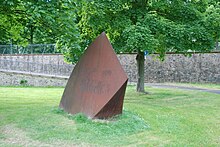Michael Croissant

Michael Croissant (born May 7, 1928 in Landau in the Palatinate ; † September 21, 2002 in Munich ) was a German artist and sculptor .
biography
Croissant spent his early childhood in Berlin . From 1934 to 1938 he lived in Vienna , then again in Landau, where he began an apprenticeship as a stonemason in 1942. He then attended the School of German Crafts in Kaiserslautern from 1943 to 1946. From 1946 to 1948 he took lessons at a private art school in Munich and studied from 1948 to 1953 at the Academy of Fine Arts in Munich with Toni Stadler .
In 1953 he married the artist Christa von Schnitzler . 1953 to 1966 he lived and worked freelance in Munich. From 1966 to 1988 (22 years) he was a professor at the Städelschule in Frankfurt. Since 1991 he lived and worked in Haar-Gronsdorf near Munich. Croissant died on September 21, 2002 .
He was a member of the Palatinate Artists Working Group , the Palatinate Secession , the Darmstadt Secession , the New Munich Group and, from 1972, a member of the Academy of Fine Arts in Munich.
Works
“All of Michael Croissant's works, as abstract as they may seem, show people. In his body pillars, and even more so in his head, the artist succeeds in bringing the industrial material of welded steel plates to life. Feelings are not set up as an expressionist gesture, clearly visually comprehensible, but remain enclosed in the head-body, understandable only as restrained, inner, inner tension of the slightly curved sheet metal as traces of the processing on the edges and on the surface of the steel or bronze . In the reduction to the head, to that part of the human body that is commonly seen as the carrier of the mind, of reason, in the separation from the body, he tries to reformulate the human face in his contemporaneity and to take a look behind it, in the headspace, in the people. " (Quote from Scheffel Gallery, Bad Homburg)
“The early bronzes feel their way from the natural form to the amorphous, to a certain extent to the early stages of material, merely brooding existence. Since the mid-1970s he has been welding iron, lead and bronze surfaces to form massive figures or heads, increasingly abstract signs of a spirit that dominates matter. From 1980/81, Croissant worked with 3 - 4 mm thick bronze plates from which he cut out segments and welded them together to form figures and heads that were either lying or standing upright. This way of working, to which he remains true to the end of his life, gradually leads the artist to a formalization of the figure motif towards a construct. In doing so, he succeeds - and this is the great achievement of his late work - with the greatest possible reduction of the figure to a geometric hollow form, each sculpture with its own outline, to preserve a physical, existential presence. " (Quote from Ronald Appel, Galerie Appel, Frankfurt / Main )
Awards and honors
- 1955: Scholarship from the cultural group in the Federal Association of German Industry
- 1956: ars viva
- 1959: Participation in the Middelheim Biennale
- 1960: Palatinate Prize for Fine Art from the Palatinate District Association
- 1962: Art Prize of the City of Darmstadt
- 1964: Promotion Prize for Fine Arts of the City of Munich
- 1966: Hans Purrmann Prize
- 1978: Art Prize of the State of Rhineland-Palatinate
- 1985: Reinhold Kurth Art Prize from Stadtsparkasse Frankfurt am Main for the complete work
- 1994: Max Lütze Medal
- Federal Cross of Merit 1st Class (August 25, 1993)
Solo exhibitions (selection)
- 1964 Kunsthalle Darmstadt
- 1976 Forum Kunst, Rottweil
- 1978 Carmelite Monastery, Frankfurt am Main ; State Museum Kassel (New Gallery)
- 1982 Michael Croissant, sculptures and drawings - Kunsthalle Bremerhaven
- 1983 Museum of non-representational art , Otterndorf (together with the painter Andreas Brandt )
- 1989 Institute for Modern Art Nuremberg
- 1990 Museum Pfalzgalerie Kaiserslautern ; Glaskasten Sculpture Museum, Marl
- 2003 Michael Croissant (1928-2002) - Georg Kolbe Museum , Berlin
- 2004 Rathausgalerie, Munich
- 2005 Michael Croissant, Heads 1952 - 2002 - Museum Lothar Fischer , Neumarkt
- 2008 Michael Croissant, Figures and Heads - Museum Pfalzgalerie Kaiserslautern
- 2011 Michael Croissant. Drawing and sculpture - Museum of Modern Art Wörlen , Passau
literature
- Croissant, Michael . In: Supreme Building Authority Munich (Hrsg.): Bildwerk Bauwerk Artwork - 30 years of art and state building in Bavaria . Bruckmann, Munich 1990, ISBN 3-7654-2308-4 , p. 36, 56-57 .
- Alexander Bastek (arr.): Of heads and bodies. Frankfurt sculpture from the Städel , Frankfurt a. M .: Städel 2006, ISBN 9783935283113 , pp. 259-261.
Web links
- Biographical information on Michael Croissant (Georg Kolbe Museum)
- Literature by and about Michael Croissant in the catalog of the German National Library
- The world of Michael Croissant - Croissants Working in public spaces
Individual evidence
- ↑ Peter Anselm Riedl: Michael Croissant. Prestel, Munich, 2002
- ↑ Ars Viva
- ↑ Information from the Office of the Federal President
- ↑ a b Michael Croissant work text. In: Galerie Jahn and Jahn. Retrieved January 3, 2020 .
| personal data | |
|---|---|
| SURNAME | Croissant, Michael |
| BRIEF DESCRIPTION | German sculptor and artist |
| DATE OF BIRTH | May 7, 1928 |
| PLACE OF BIRTH | Landau in the Palatinate |
| DATE OF DEATH | September 21, 2002 |
| Place of death | Munich |


